Chimneys can be problematic areas of a property for several reasons. Chimneys are:
- Open structures: easily subject to rainwater ingress
- Large, solid pieces of masonry: which can potentially store lots of moisture
- Subject to fire and large temperature variations
Chimney Problems
As a result, here are the most common chimney problems.
1. Rainwater Ingress
Rainwater can easily find its way down and into the chimney stack as a result of wind driven rain. Rainwater can find its way into the chimney through the cracks of the mortar joints or through the flashing.
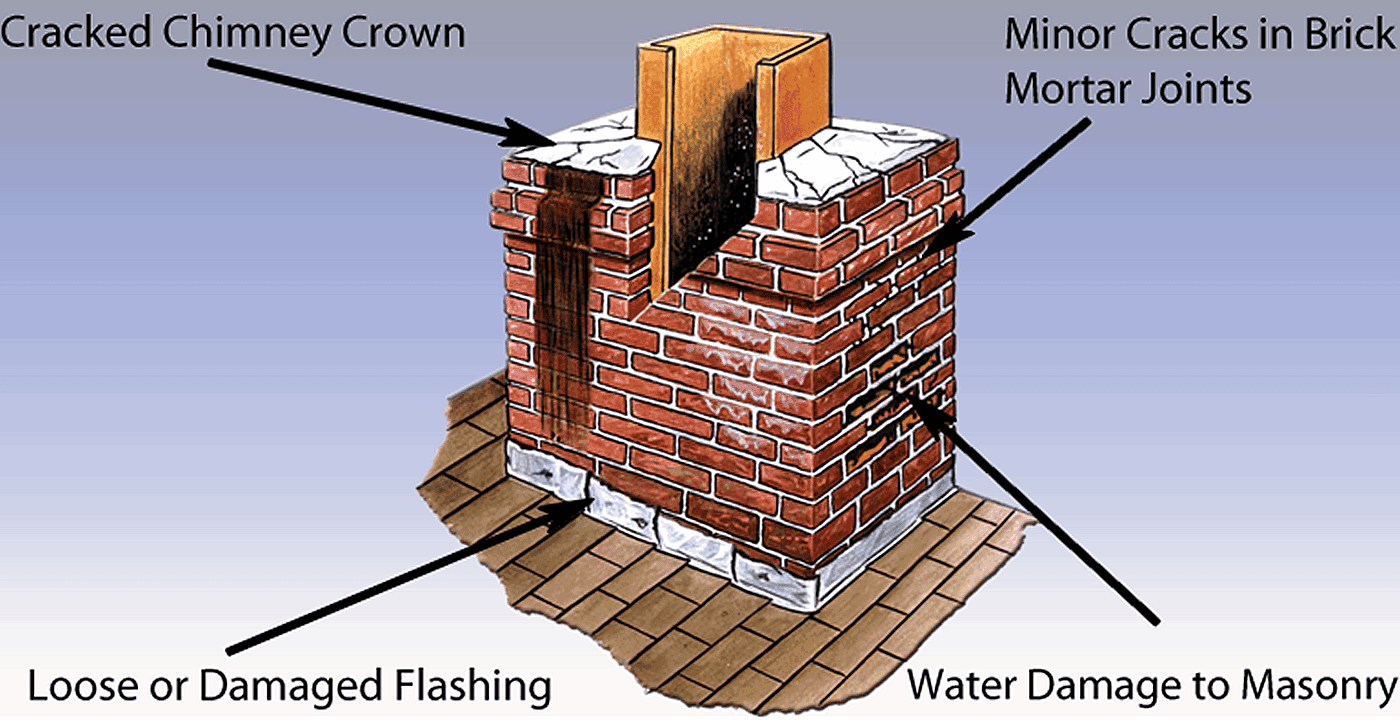
Sources of rainwater ingress
To minimize the rainwater ingress, chimneys can be capped.
Rainwater ingress not only leads to unsightly damp patches on walls along the chimney flue but the chimney soot washed down by the rainwater causes far more damages to the masonry than water.
2. Chimney Salts - Mysterious Dampness Problems?
Chimney salts can cause some of the most mysterious dampness problems on chimney walls. These can include discoloration, mysterious hazy damp patches, paint damages, crumbling of the plaster which can even occur on internal walls not subject to driving rain, leaving old building owners puzzled about the source of these problems. These patches may come and go - they fade during the warmer summer then suddenly reappear in full force after some intense rain.
Most of the time, in such cases, poor pointing, wind driven rain or chimney leaks are suspected to be the cause of these problems, however a thorough inspection of the chimney (pointing, chimney stack and flashing) reveals nothing out of the ordinary. Sometimes, in a desperate effort to solve the problem, the chimney stack is completely removed, yet the dampness problems reappear after some time even if the chimney stack is no longer present.
The source of these problems is not caused by physical water ingress, but by the electro-chemical effect of salts. It is not a water ingress problem but a chemical problem.
A chimney is typically used for decades or centuries to burn stuff, logs or coal. During the burning process soot is formed, a fine black dust that finds its way everywhere along the flue. Due to ongoing temperature changes and assisted by rainwater leaks, the soot migrates into he mortar, finding its way near the surface, causing yellow, brown or black discolouration along the chimney walls.
But there is more to it! Salts in contact with water form ions, a fancy name for any electrically charged molecule. Salt ions can attract and trap humidity (water vapours) from the environment, accumulating a significant amount of moisture. Moisture accumulation by salts results in hazy damp patches on the surface of the walls. Moisture tends to accumulate along the saltier areas of the plaster, as dampness is held in place by the electrical charges of the salt ions,
Once salts find their way into the building fabric, they cause a number of irreversible changes. During the winter period when the ambient humidity is high, salts liquefy and the damp patches expand. During the summer, when the ambient humidity is lower, salts tend to slowly dry out and the damp patches fade. However, during drying the salts also solidify and crystallize, expanding in volume 5-10 times. This volume expansion during drying leads to the physical breakdown of brick, stone or plaster resulting in crumbling.
Here are some examples of walls affected by soot and salts.
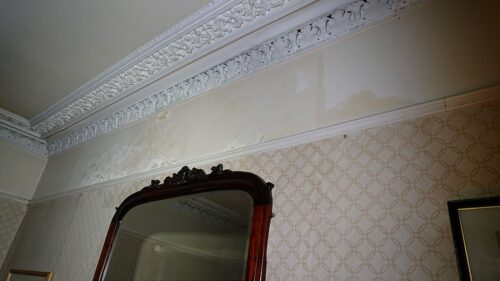
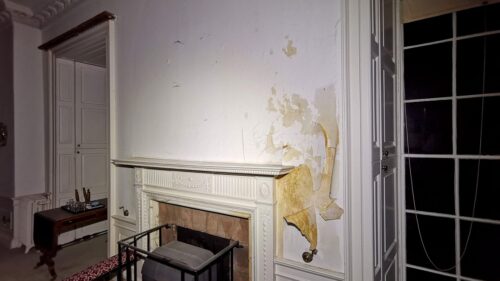
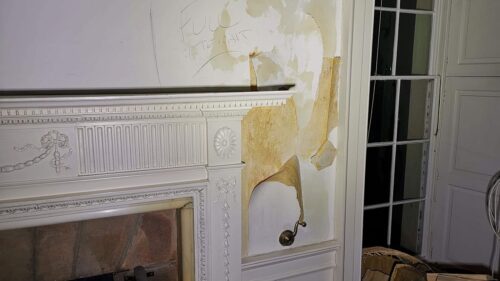
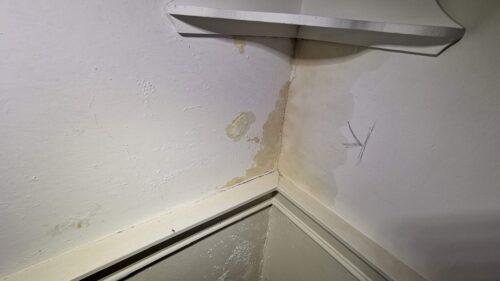
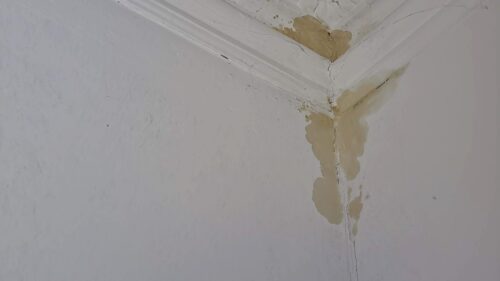
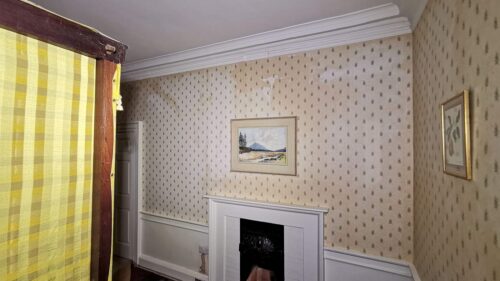
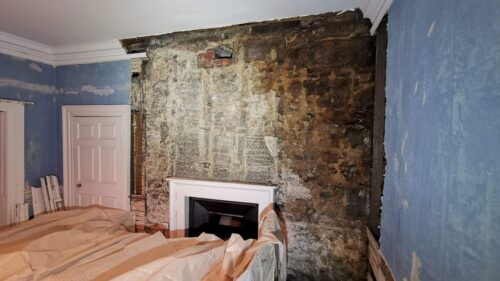
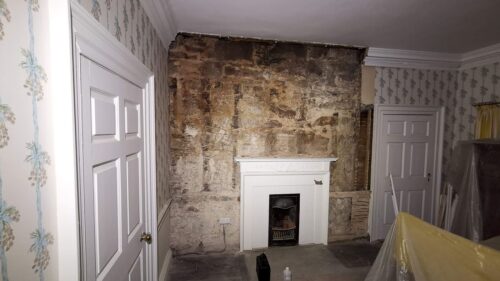
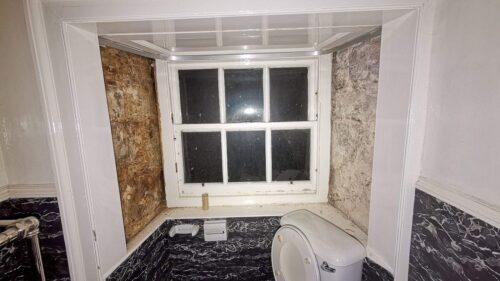
Salts cause major problems to old buildings, being the main cause of historic fabric loss. Research experiments have conclusively demonstrated that crumbling is not caused by high humidity but by salts. You can read more about the various problems caused by salts in old buildings here,
3. Rising Damp
Near the base of old chimneys, rising damp is one of the most common problems. Because old chimneys also contribute to the structural reinforcement of old walls, they can have a considerable size, thickness and volume. Sitting on the damp ground, they are affected by ground moisture which over time leads to the development of rising damp.
The thicker and the more voluminous a masonry is, the more water it can store, as highlighted by a prominent British research paper.

Some facts and figures about rising damp
Solutions
Solving these problems is not complicated if the right materials and technologies are used.
1. Solving Rainwater Ingress
Solving rainwater ingress is quite straightforward. A thorough chimney inspection can usually locate the points of water ingress and fixing that will resolve the problem.
2. Solving Salts Related Chimney Problems
Solving salts related problems is usually done by replastering. The common solution is replastering with a modern sand-and-cement plasters with a gypsum finish as nowadays most builders use modern materials. The benefit of this solution is that cement plasters can withstand the effect of salts longer than lime, however being a non-breathable material the use of cement plasters in old buildings is definitely not recommended.
In order to keep the wall fabric breathable, replastering with lime is a much better option. However, a regular lime plaster in a humid and salty environment lime is often not resilient enough to withstand the effect of salts for very long, resulting in its premature breakdown.
There are, however, special lime plasters of which origins stretch back to ancient Rome. Being outstanding architects and builders, the Romans have discovered that by adding certain volcanic soils and other minerals to lime, they can significantly alter its properties, including its mechanical strength, water and salts resistance, while retaining its breathability.
The materials most commonly added to lime were natural pozzolans (volcanic soils or rock fragments) and cocciopesto (milled bricks or terracotta fragments). These reacted chemically with the free lime, forming water resistant compounds. Such mortars were able to harden quicker not only in the presence of water but even underwater in the total absence of air, and they are known as hydraulic mortars (water limes). Because the volcanic ingredients have already been pre-burned by the volcano, mixed with lime these result in incredibly breathable plasters.

Natural pozzolans are very breathable
The Rinzaffo MGN Roman lime plaster is salt resistant and breathable at the same time. This lime plaster can withstand the effect of all masonry salts, including chlorites (sea salts), nitrates (ground salts) and sulphates (chimney salts) for decades, without breaking down. It can also withstand potential water ingress from the chimney stack, acting as a water barrier, protecting finished wall surfaces from damages.
To resolve the damp patches and discolouration of chimney areas permanently, the following renovation schedule is recommended:
- Hack off the existing plaster to stone or brick. Do not just skim over the existing plaster!
- Clean all surfaces well to be free of dust and salts.
- Apply a min 10 mm coat of Rinzaffo MGN Roman salt-resistant lime base coat across the area being renovated.
- Apply a good quality lime decorative coat or a thermal plaster.
- Apply a good quality lime finish.
The renovation process is outlined below.
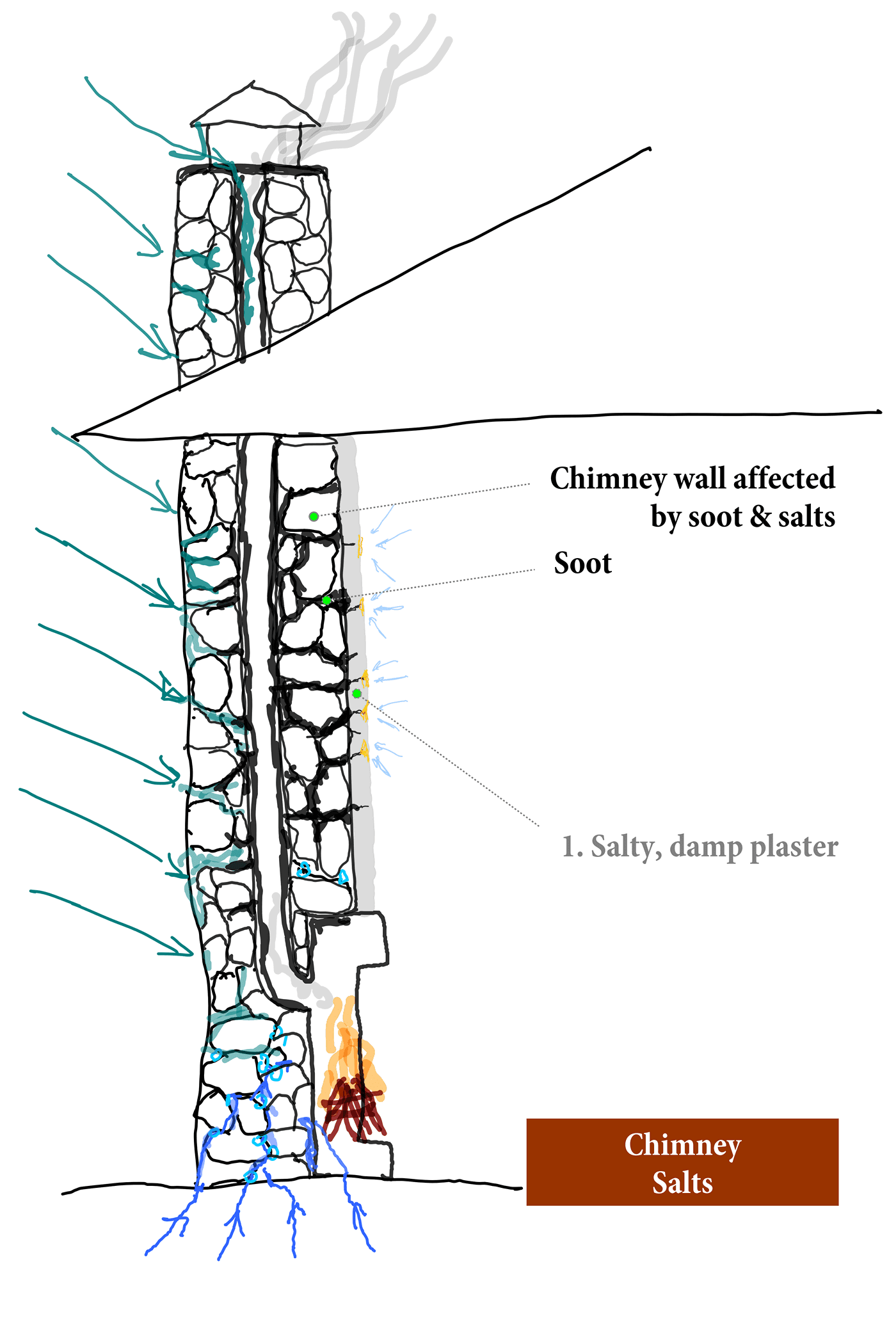
Chimney salts
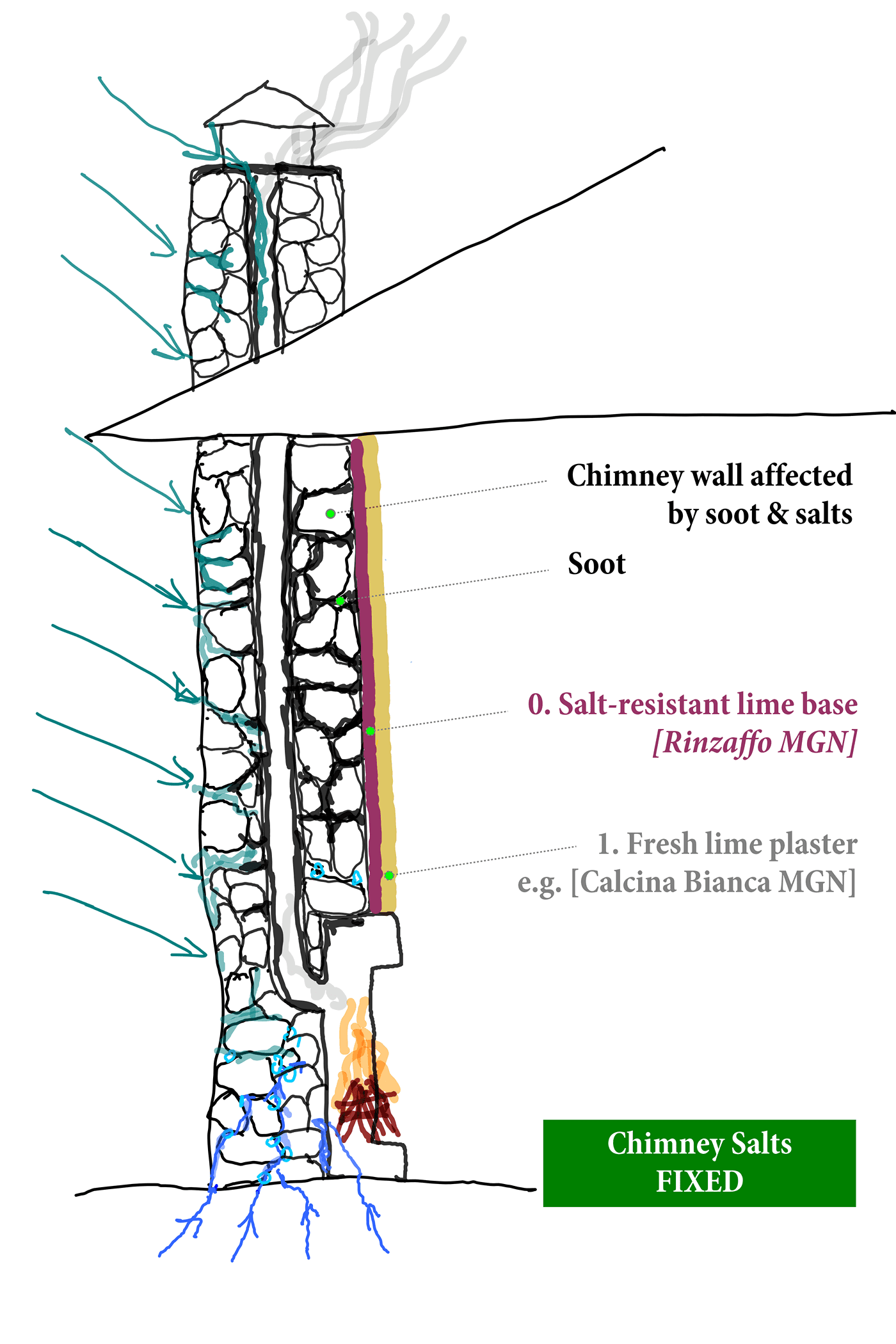
Chimney salts fixed
3. Solving Rising Damp
Solving rising damp is discussed in detail here. The magnetic DPC technology is a great non-invasive, alternative that can be applied easily in any building included listed buildings.

